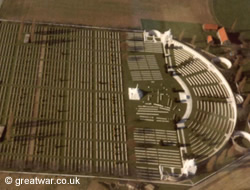Ypres Salient Battles 1917
- Battle of Messines, 1917
07-Jun-1917 —
14-Jun-1917
The new Front Line (green dashed line) at the end of the Battle of Messines on 14th June 1917. The German Army had successfully been pushed off the Messines Ridge. 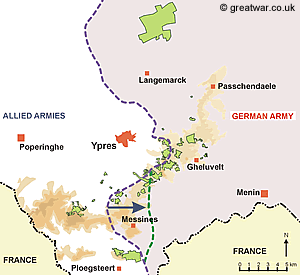
The Battle of Messines was an offensive by the British Second Army against the German Front Line on the high ground of the Wytschaete-Messines Ridge. The ridge lay in a north to south direction a few miles south of the town of Ypres. Two of the villages on the ridge were Wytschaete (called “Whitesheet” by the British troops) and Messines (now known by its Flemish name of Mesen). General Herbert Plumer was commander of the British Second Army. The German Army called this position the Wytschaete-Bogen, which translates as the Wytschaete Bow or Curve.
Planned from 1916, the Battle of Messines was to be a prelude to the Third Battle of Ypres, which had the high ground of the Passchendaele Ridge to the north-east of Ypres as its objective. The objective of the Messines June offensive was to remove the German Army from its domination of the positions on the high ground of the ridge south of Ypres, which they had held since October 1914. A successful operation at the Wytschaete-Messines ridge would break through the German Front and straighten the British Front Line, thereby reducing the manpower needed to man it, and place the Allies in an improved position south-east of Ypres. They would then be in a better position to protect the right flank of the large-scale British attack planned for the end of July to the east and north-east of Ypres.
Australian troops studying a large relief model of Messines Ridge before the battle. Thorough preparation and planning were a key feature in the success of the operation on 7 June. GWPDA(1) 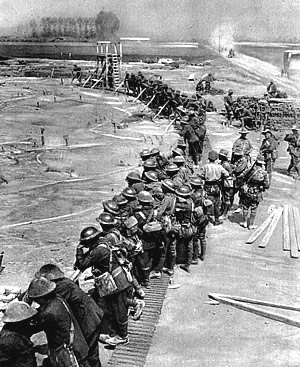
From the early spring of 1916 mining operations were carried out to dig the tunnels and lay the explosive for a total of 21 mines. The troops involved in the mining were military tunneling companies and engineers from the Australian, British, Canadian and New Zealand forces.
In the early hours of the launch of the attack, 7 June, 19 of the 21 mines were blown at 3.10am. The German defenders on duty in the Front Line were shocked and hurled into the air, along with concrete bunkers, equipment and tons of earth. 19 enormous craters were left after the debris had crashed back down again. A dull rumble from the explosions was said to have been heard in London.
British, Irish, Australian and New Zealand infantry carried out the assault on what was left of the German line and over 7,000 German prisoners were taken. Artillery and tanks moved up, German counter-attacks were held off and by the end of the first day the British objectives had been reached.
The largest of the mines, packed with 41 tons of ammanol explosive, was located over 80 feet below ground under the German position at Spanbroekmolen. This was the location of a windmill by that name. The crater has filled with water and has been preserved as a memorial site, a “Pool of Peace”.
In the centre section of the attack on 7 June the 36th Ulster Division and the 16th Irish Division advanced side by side. A memorial to the men of these Irish divisions and all men of Ireland who fought in the First World War is located at Messines (Mesen):
- Third Battle of Ypres, 1917
31-Jul-1917 —
10-Nov-1917
The Front Line (purple dashed line) extends to Passchendaele, several miles north east of Ypres, by the end of 10 November 1917 after the Allied offensive of the Third Battle of Ypres. 
From early in 1916 it was the intention of the Commander-in-Chief of the British Expeditionary Force (B.E.F.), Field Marshal Sir Douglas Haig, to break out of the Ypres Salient. Having successfully secured the high ground of the Wytschaete-Messines Ridge in the Battle of Messines (7-14 June) the plan for the next operation was to advance against the German Front Line east and north-east of Ypres. On reaching the strategically important high ground of the Passchendaele Ridge to the north-east of Ypres, the British intention was to continue to push westwards, cutting off access for the German forces to the Belgian ports of Ostende and Zeebrugge. German forces were in control of these ports and using Zeebrugge in particular for shipping and submarines (U-Boats).
A British offensive in Flanders before the autumn weather closed in would also draw the focus of German Army commanders away from the Aisne battlefield. The large-scale offensive on the Chemin des Dames Ridge in April of 1917, planned by the French Commander-in-Chief, General Robert Nivelle, was a failure. Very high casualties for the French Army resulted in a struggle to maintain discipline in some of its units and soldiers mutinied.
German prisoners being marched through Ypres during the Battle of the Menin Road in September 1917. The damaged building on the right is St. Martin's cathedral. The gateway on the left is the cloistral gate to the St. Martin's convent. GWPDA(2) 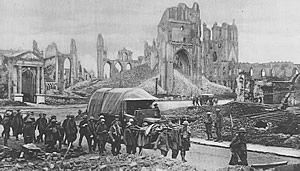
In Flanders, the Third Battle of Ypres was launched on 31 July. The British Fifth Army commanded by General Hubert Gough advanced in a north-easterly direction away from its positions near Ypres with the Passchendaele Ridge in its sights. The French First Army was on its left. The British Second Army, under General Herbert Plumer, was on its right, holding the ground won during the Battle of Messines a few weeks earlier. Some ground, approximately two miles, was gained on the first day, but that night rain began to fall. The ground all around the British attackers quickly turned into a quagmire. Churned up by the artillery bombardment of the German Front Line and rear areas, the ground the British were now having to advance across was badly damaged and filling up with of rainwater which could not drain away through the heavy clay soil. Added to this, several small streams flowed through the area and their natural drainage channels had been destroyed. Due to persistent rain over the next few weeks the whole operation became literally bogged down in thick, sticky Flanders mud. Conditions were so bad that men and horses simply disappeared into the water-filled craters.
The German defensive line had been fortified during the previous months in their expectation of an attack here. The British advance turned into a battle of 8 phases, inching closer to the Passchendaele Ridge in a series of actions with limited objectives. The capture of the Passchendaele Ridge eventually took over 8 weeks to achieve.
British supply horse stuck in Flanders mud. GWPDA(3) 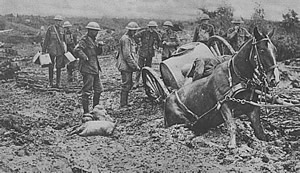
The cost to both sides in human casualties was immense at between 200,000 and 400,000, although exact figures for British and German casualties continue to be a matter of discussion for military historians. The great tragedy for the British Army and the Imperial Forces of Australia, New Zealand and Canada, who suffered so many losses in the fight for the few miles from Ypres to the Passchendaele Ridge, is that only five months later almost all of the ground gained in the mud and horror of the battles for Passchendaele was recaptured by the German Army during its April offensive in 1918.
The Third Battle of Ypres comprised 8 phases. Formally called the Third Battle of Ypres, the battle which began on 31 July often takes the name it is more commonly known by, the Battle of Passchendaele, from the First and Second Battles of Passchendaele, which were in fact the last two phases of Third Ypres.
- Battle of Pilckem Ridge
31-Jul-1917—
02-Aug-1917
- Battle of Langemarck, 1917
16-Aug-1917—
18-Aug-1917
- Battle of the Menin Road Ridge
20-Sep-1917—
25-Sep-1917
- Battle of Polygon Wood
26-Sep-1917—
03-Oct-1917
- Battle of Broodseinde
04-Oct-1917
- Battle of Poelcapelle
09-Oct-1917
- First Battle of Passchendaele
12-Oct-1917
- Second Battle of Passchendaele
26-Oct-1917—
10-Nov-1917
Many thousands of the casualties on both the Allied and German sides were killed in the fighting during the Third Battle of Ypres. Thousands were listed as missing in action and whose remains, if found, have never been identified.
- Battle of Pilckem Ridge
Next >> Ypres Salient Battles 1918
Further Reading

Pillars of Fire: The Battle of Messines Ridge, June 1917 (paperback)
by Ian Passingham
A detailed account of the successful British Battle of Messines in June 1917 told from the British, ANZAC and German perspectives. Includes illustrations and maps. Revised and reprinted in 2012.

Messines Ridge: Ypres (Battleground Europe Series) (paperback)
by Peter Oldham
An account of the Battle of Messines in June 1917 in the highly acclaimed Battleground Europe series of guidebooks. Illustration, maps, and information on what you can see on the battlefield today.

They Called it Passchendaele: The Story of the Battle of Ypres and of the Men Who Fought in it (paperback)
by Lyn MacDonald
Originally published in the 1990s this highly acclaimed account of the Third Battle of Ypres (Battle of Passchendaele) tells the story from the perspective of the men who fought it.

Ypres 1917 (hardback)
by Norman Gladden
A fascinating personal account by Norman Gladden who served with the Northumberland Fusiliers during the Third Battle of Ypres in 1917.

The German Army at Passchendaele (hardcover)
by Jack Sheldon
An account of the German Army's experience of its defence against the British offensive of the Third Battle of Ypres in the summer and autumn of 1917. Using German archive material Jack Sheldon provides the perspective of events from the German side.
Related Film

Beneath Hill 60 (DVD)
from the book by Will Davies, starring Steve le Marquand, Chris Haywood. Directed by Jeremy Sims.
The amazing true story of the men in the 1st Australian Tunneling Company, which dug the mine destined as one of the 19 huge mines to be exploded under Hill 60 at the start of the Battle of Messines in the early morning of 7 June 1917. Momentum Pictures Home Entertainment. DVD release date: 11 Oct 2010.
Related Topics
Tyne Cot Memorial to the Missing, Zonnebeke
The Memorial to the Missing at Tyne Cot Cemetery bears the names of 34,925 United Kingdom and New Zealand soldiers missing in action and presumed killed on and after 16 August 1917.
Tyne Cot Memorial to the Missing
Tyne Cot Cemetery, Zonnebeke
11,956 graves of Commonwealth servicemen are located in Tyne Cot Cemetery. It is the largest British and Commonwealth cemetery in the world. Of these graves 3,588 are identified.
Langemark German Military Cemetery
Over 44,000 German soldiers are buried in this cemetery, many of whom died during the Third Battle of Ypres.
Langemark German Military CemeteryMemorial Museum Passchendaele 1917
Located in the chateau at Zonnebeke village, the museum tells the story of the First World War in the Ypres Salient with special emphasis on the Battle of Passchendaele 1917.
Memorial Museum Passchendaele 1917
Acknowledgement
GWPDA(1), (2), (3) Photographs with grateful thanks to the Great War Primary Document Archive: Photos of the Great War.

